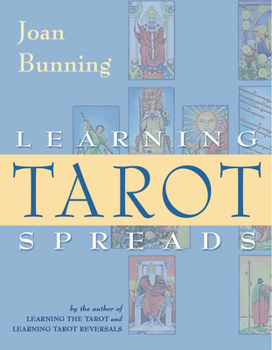Learning Tarot Spreads
Each tarot reader has a unique style that they hone over time into the fine art of divining the future. In this essential guide to arranging cards into prophetic patterns, Joan Bunning has compiled a veritable encyclopedia of tarot spreads with great appeal for accomplished readers who want to explore further as well as novices with their very first deck. What sets Joan Bunning apart from every other writer on the subject of tarot is her ability to...
Format:Paperback
Language:English
ISBN:1578632706
ISBN13:9781578632701
Release Date:February 2007
Publisher:Weiser Books
Length:180 Pages
Weight:0.80 lbs.
Dimensions:0.6" x 7.1" x 9.0"
Customer Reviews
3 ratings
Learning Tarot Spreads
Published by Thriftbooks.com User , 16 years ago
Tarot spreads can be extremely versatile. In fact, there are many ways to tailor spreads to an individuals needs be they insight into a generalized question or very precise information about a particular question (or aspects of that query) within a chosen span of time. Despite this versatility though, most of us tend to have a couple of favourite spreads that we use no matter what our intention. I am definitely amongst the majority of tarot card users. I have two spreads that I tend to use the most and because of this fact I often find myself frustrated when I would like a little more understanding of how a situation came to be, when I'd like more detail about a particular question, or when I could use a little more guidance. That's why I really enjoyed working through Learning Tarot Spreads. This book doesn't just illustrate a bunch of new tarot spreads that I will try once and likely never use again. Instead, the author sets out to teach the reader how the shape, position, and relations of cards as individuals and as part of an entire spread react, interact, and compliment each other. Readers learn through trial and error while undertaking different exercises set out in the text. Once armed with this knowledge, the reader can easily make up his or her own tarot spreads in order to work with any query or purpose that they may choose. I really like the freedom or creating my own tarot spreads and the piece of mind that these spreads are properly balanced and suit my intention.
Very informative, as always......
Published by Thriftbooks.com User , 17 years ago
Joan Bunning is a terrific author on the Tarot. I took her online course from Barnes and Noble "Learning the Tarot" and it was a great start for me to begin using the cards. Now she devotes a whole book to spreads which is a much needed addition to my library. The book is in lesson format with exercises at the end to assist in retaining the knowledge you are studying. It has a lot of information not found in other books and I highly recommend it.
Methodical Approach to Spread Creation
Published by Thriftbooks.com User , 17 years ago
"Many people get discouraged once they've learned the tarot basics. They lack a model for how to integrate the tarot into their lives in an ongoing way. Learning Tarot Spreads gives them just that. They learn how to assess a reading situation and then create the ideal spread for it. Learning Tarot Spreads will also interest experienced readers. It offers tarot tools to help them unify and deepen their practice." - Joan Bunning After giving us Learning the Tarot and Learning Tarot Reversals, author Joan Bunning now turns her attention to the subject of tarot spreads. With systematic lessons similar to the previous books, Learning Tarot Spreads deconstructs the shapes, subjects, position meanings, and patterns of tarot layouts, providing a flexible model applicable to any reading. Acknowledging the tension between structure and freedom when performing a reading, Bunning reminds readers that tarot spreads provide a framework for guiding and directing intuition. The methods outlined in Learning Tarot Spreads gives readers the flexibility to improvise and draw upon higher wisdom while at the same time apply intellectual analysis to the underlying "facts" of a reading. Keeping the main subject (the focus or gist of the reading) at the center of a spread, Bunning explains the nature of related people, areas of life, situations, and time periods--and the location of the card positions related to these areas. For example, while the main subject stays at the center, cards signifying related people would be placed below, related areas of life would be placed to the left, related situations would be laid out above, and related time periods would go to the right. Bunning also explains the difference between situations and areas of life, noting that areas of life are long-term--such as health, career, spirituality, and finances. Situations, however, have a goal or a definite beginning and ending--work assignments, celebrations, an argument, and choices. In-depth charts and card layouts comprise about 50 percent of Learning Tarot Spreads, further helping readers discern which areas and qualities to explore, as well as how to interpret cards in a myriad of positions. Bunning offers exhaustive analysis of opposing quality positions, such as Avoiding/Embracing, Strong/Weak, Blocking/Clearing, Active/Inactive, Enduring/Temporary, and so on. For example, for the quality "Avoiding", Bunning provides keywords, a description of the quality, reversed meaning, the opposite position, and the flex-spread card placement. A portion of her description for "Avoiding" says: "To avoid means to deny or push away. If we fear or dislike something, we keep our distance. We try to pretend it's not true or doesn't' exist. A card in avoiding shows something the main subject is resisting or denying. You may be avoiding your power (Magician). You may be refusing to be a martyr in some area of your life (Ten of Swords). A situation may involve someone who's denying rejection (Fi




